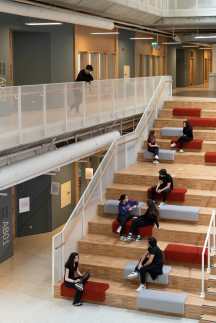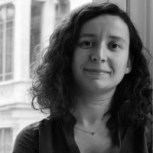
Design for learning beyond the classroom
Pınar Gökbayrak looks back on her journey as a school architect, reflecting on classrooms, a school’s ‘forgotten places’ and the community.
The impact of learning spaces on users
All learning spaces have a powerful impact on people of all ages, people who use them day in, day out. According to the founder of Reggio Emilia, Loris Malaguzzi; a school’s physical environment is the “third teacher” for a child after adults and his/her peers.
Environment as the third teacher: Teachers provide a well-planned environment with provocative materials as well as meaningful experiences in the world. This leads them to describe the environment as a ‘third teacher’.
The research pays testament to the effect of physical environments on the learning process, and we can even argue that architectural space has the potential of being a catalyst for change in education itself. If this is the case, it almost goes without saying that there must be an alignment between a school’s vision, its curriculum, pedagogy . . . and its learning environment. One idea we have been continually exploring with educators is ‘student-centered learning’ and as we did so, our belief that learning extends way beyond the classroom has never been more true. This takes us as architects to a number of questions: What is a classroom and how can we develop and diversify the experience in it? Further – how can learning go beyond the time and space allocated to fixed classrooms?
First steps
The first step on our school design journey started, as it has for so many others, with what we all called ‘the classroom’. If we wanted children to become active learners, first we had to rethink the fixed positions of ‘the board’ and the teacher’s desk as the only focus of a forward-facing group of children arranged in rows. Giving children different opportunities to participate in class – working as an individual at a single desk, around a group table, on a higher stool or on a cushion as well as part of a class listening to a teacher led us to believe that all learning spaces space should be designed with this kind of flexibility in mind from the very start.

Going further
But we needn’t stop there. Why not include more informal settings outside the ‘closed box’ of the classroom as potential learning spaces? Why not ignore the walls of the classroom and spread learning experiences to the whole building?
Corridors, common spaces, ‘left-over rooms’ with little access then become potential spaces for creating incidental encounters or for new experience-based nodes and zones that will trigger student curiosity and interest.

Instead of tolerating an empty and dull corridor where students just pass by, why not install a variety of seating, which will enable teachers to organize group work in new breakout spaces, allow children to hang out, chat or work with a friend, collaborate in a lager group, rehearse for a play or practice their debating skills. Time and space for learning experiences will then extend to the whole building, which will become a more natural and fulfilling part of daily student life quite naturally.

Then, we realized we can travel in reverse: Informal spaces can also be injected into classroom settings for alternative seating to create single concentration study zones, comfortable group work areas or soft relaxation areas. This will also allow the teachers to design alternative ways of conducting a lesson.
Design conversations

A really successful school environment that optimizes every space in a building for learning can only really be achieved if and only if designers and educators are on the same page about the vision for the institution. In our experience, educators and architects working together is the keystone of successful school design, which is only possible when the users of the school embrace and feel a sense of belonging to their physical environment. Student and teacher discussion is critical. They need to air their complaints, express their future dreams and past memories within the framework of the design process.
There are alternative ways of involving the designer in this, but for us, the key factor is to allocate time for the design team to get to know the school and its users before starting discussions on the project brief. If there is a particular school community that needs their campus remodeled or extended, we like to spend time in that community, interviewing students, teachers, administrators, caretakers, alumni and parents.
We attend classes, stroll around campus, watch extracurricular activities and social gatherings to map out a user-experience guide that unveils the daily outcomes of the culture of the school. We can then suggest how that culture can be reflected and extended in a set of new spaces. When educators and designers are open to the idea of dreaming together and putting effort and time into this dreaming phase, then the design itself all comes in a smooth way that often exceeds everyone’s expectation.
Breaking down perimeter walls
Even when there is not a specific user group of teachers and students to work with yet, then we can turn to the neighborhood and invite the community to see themselves as part of the school ecosystem. In some cases, the community can be part of the design process and in others the community can even be considered as one of the final users of the school building.

This approach can achieve extraordinary results. In one of our projects, we designed an ‘open campus’ with no gates, accessible ground floors, multipurpose halls and courtyards for different communities as well as students to use. A ‘smart layout’ for the buildings was designed to invite the community into the school so that social facilities (gymnasium, cafeteria, auditorium, library) could be used by local people after-school hours. And so, the school came to belong to the community in a very real sense and was quickly established at the center of the daily life of the town.
Our learning journey
In a very real sense, we have been on our own design learning journey. First we considered new possibilities for classrooms. Then we looked at the potential of spaces outside the classroom and now we have gone even further, beyond the limiting walls of a school and into the community. It will be interesting to see where this journey takes us next.
One thing is for sure: liberating spaces successfully for different ways of learning means bringing designers, teachers, students and even the community together in order to exchange ideas and re-imagine their future.
 Pınar Gökbayrak is an award-winning architect and one of the three founders of the PAB Architectural Practice in Istanbul.
Pınar Gökbayrak is an award-winning architect and one of the three founders of the PAB Architectural Practice in Istanbul.
Pinar was also one of the founders of pabedu in 2016, a collaborative enterprises that brings together experts from different fields of the educational ecosystem to design innovative learning environments and school buildings with the leading role of PAB Architects: https://www.pabedu.com/
All images kindly provided by PAB Architectural Practice
Photo Credit
FEATURE IMAGE: An open campus to all – Yercekim Photography
Support Images
1 & 2 Seating alternatives and a diversified classroom setting – PAB Architects
3 & 4 Informal learning and socializing spaces in common areas – Emre Dorter
5 An open campus to all – Yercekim Photography
Further reading
https://www.education-ni.gov.uk/articles/community-use-school-premises
https://www.education-ni.gov.uk/publications/community-use-school-premises-guidance-toolkits
https://www.gov.wales/annex-4-developing-community-engagement-community-focused-schools-html

